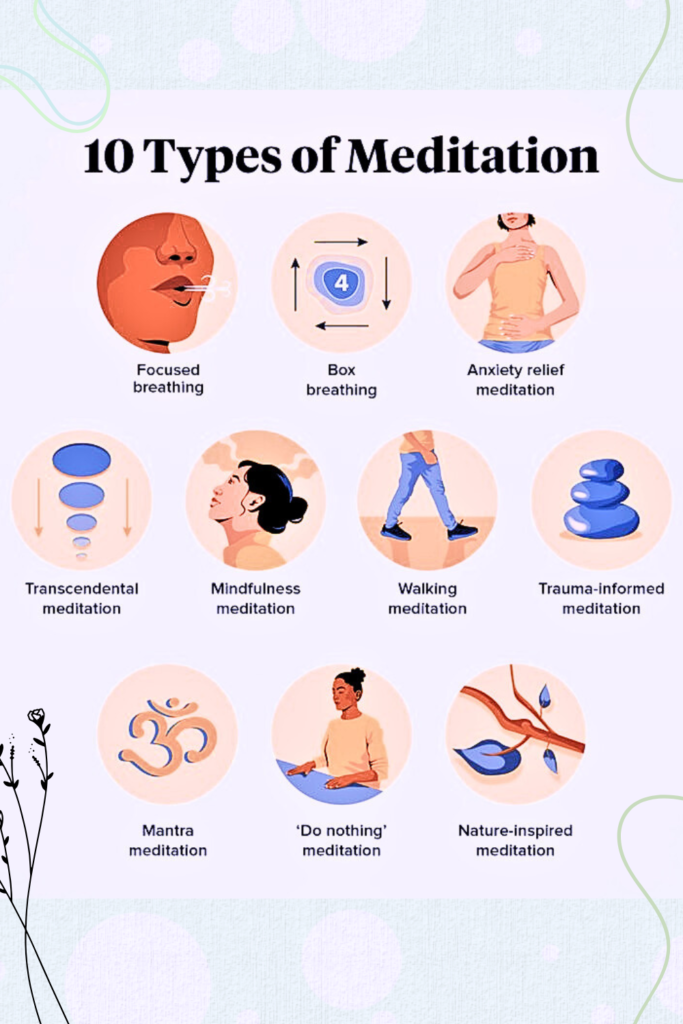Meditation offers a plethora of mental and physical health benefits, but with so many techniques available, choosing the right one can be overwhelming. Whether you’re looking for guided or unguided options, here’s a breakdown of ten effective types of meditation to help you get started on your journey.
1. Focused Breathing
Focused breathing is a fundamental meditation technique that emphasizes the breath. It’s straightforward and can be practiced anywhere.
How to Do It:
- Find a comfortable seat with a straight spine.
- Close your eyes and begin observing your natural breath.
- Pay special attention to the pauses between inhales and exhales; these gaps are where you can connect to a deeper sense of peace.
- If your mind wanders, gently redirect your focus back to your breath.
Benefits:
Focused breathing can help slow your heart rate and promote relaxation, leading to improved well-being.
2. Box Breathing
Box breathing is a powerful technique for immediate stress relief. It’s especially useful during anxious moments.
How to Do It:
- Inhale deeply for 4 seconds.
- Hold your breath for another 4 seconds.
- Exhale for 4 seconds.
- Hold your breath again for 4 seconds.
- Repeat this cycle 12 to 15 times.
Benefits:
This method stimulates the vagus nerve, which helps calm the nervous system, making it ideal for managing stress and anxiety.
3. Anxiety Relief Meditation
This meditation combines deep breathing with visualization to soothe anxiety and promote relaxation.
How to Do It:
- Find a comfortable position and close your eyes.
- Place one hand on your heart and the other on your belly. Take deep breaths and notice the supportive touch.
- Identify where you feel anxiety in your body. Assign a color or texture to it in your mind.
- As you exhale, visualize the anxiety leaving your body.
- Reflect on what you need in that moment, allowing your inner guidance to surface.
Benefits:
This practice not only calms the mind but also creates a safe space to dialogue with your feelings.
4. Transcendental Meditation
Transcendental Meditation (TM) is a structured technique typically taught by certified instructors. It involves repeating a specific mantra.
How to Do It:
- Find a certified TM teacher.
- Receive a personal mantra that you will repeat during your sessions.
- Sit comfortably with your eyes closed and focus on your mantra for 15 to 20 minutes, twice daily.
Benefits:
TM is beneficial for those with active minds, as it helps transcend thoughts rather than avoid them.
5. Mindfulness Meditation
Mindfulness meditation encourages awareness of thoughts and emotions, fostering a non-judgmental observation of your thinking patterns.
How to Do It:
- Sit quietly or engage in a repetitive activity.
- Focus on your breath or the movements you are making.
- Set a timer or repeat this process several times.
Benefits:
This practice cultivates a state of calm that can enhance your ability to stay present in daily life.
6. Walking Meditation
Walking meditation combines movement with mindfulness, making it a great option for those who enjoy being active.
How to Do It:
- Choose a quiet path to walk.
- Walk slowly, paying attention to the sensation of each step.
- Coordinate your breath with your movements, finding a rhythm.
Benefits:
This active form of meditation allows you to connect with nature while promoting mindfulness.
7. Trauma-Informed Meditation
Trauma-informed meditation focuses on creating a sense of safety and grounding for those who have experienced trauma.
How to Do It:
- Meditate in a quiet space where you feel comfortable.
- If focusing on breath or body feels overwhelming, redirect your attention to something calming, such as a natural object or relaxing music.
- Gently bring your focus back to your chosen calming element when your mind wanders.
Benefits:
This type of meditation helps create a secure environment for healing and self-regulation.
8. Mantra Meditation: ‘I Am’ Mantras
Mantra meditation uses simple affirmations to help reframe negative thoughts and enhance self-compassion.
How to Do It:
- Reflect on how you’re feeling and what you need.
- Choose a word or phrase that resonates with you (e.g., “I am enough”).
- Find a comfortable position, close your eyes, and focus on your breath.
- On each inhale, say “I am,” and on each exhale, repeat your chosen mantra.
Benefits:
Using mantras can empower your mindset and cultivate self-love.
9. ‘Do Nothing’ Meditation
This meditation is perfect for those with busy lives, allowing for brief moments of peace throughout the day.
How to Do It:
- Simply pause whatever you’re doing and take a moment.
- Take a deep inhale and a slow exhale.
- Repeat this break as needed throughout your day.
Benefits:
This practice emphasizes stillness and connection with oneself, making it easy to incorporate into a hectic schedule.
10. Nature-Inspired Meditation
Connecting with nature can improve mood and reduce stress, making nature-inspired meditation a refreshing practice.
How to Do It:
- If you can’t take a walk, find a window or a peaceful spot outdoors.
- Observe natural elements, such as the sky, trees, or leaves swaying in the wind.
- Take a moment to appreciate the natural ebb and flow around you.
Benefits:
This practice reminds you of the calm that nature can provide, promoting a sense of tranquility.
Next Steps
Finding the right type of meditation takes time and experimentation. Reflect on what you want from your practice and try various methods to see which resonate with you. You can mix and match techniques based on your needs; for instance, if you’re traveling, consider box breathing or nature-inspired meditation for quick relief.
The journey to a consistent meditation practice is personal, and the rewards are well worth the effort. Explore these types of meditation, and soon you’ll discover the techniques that best support your well-being.

